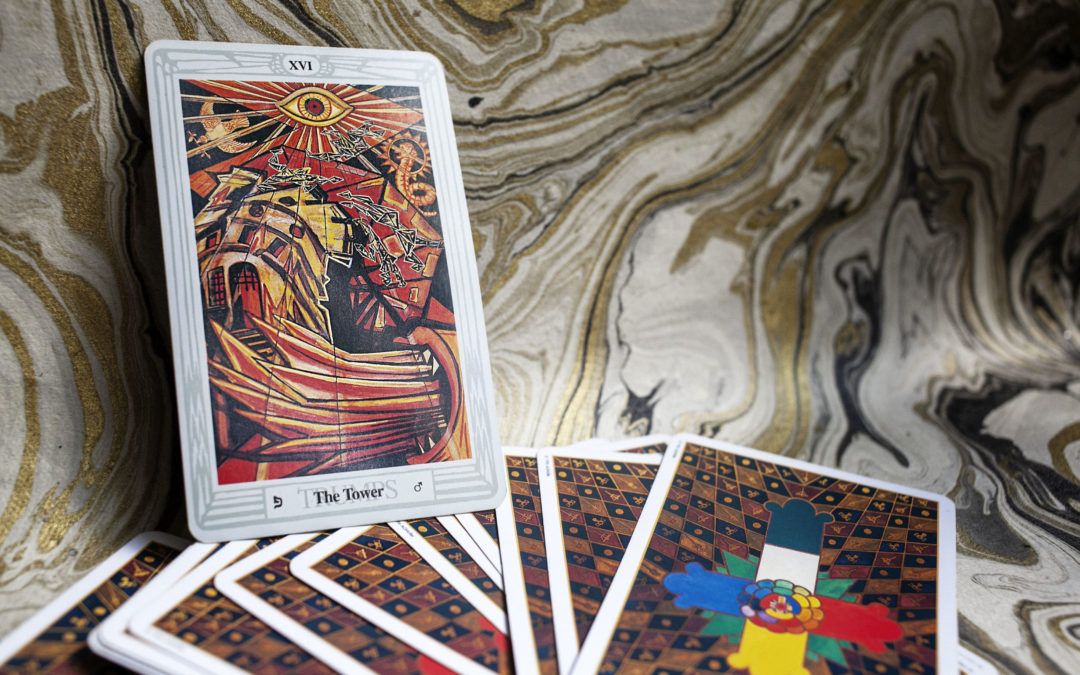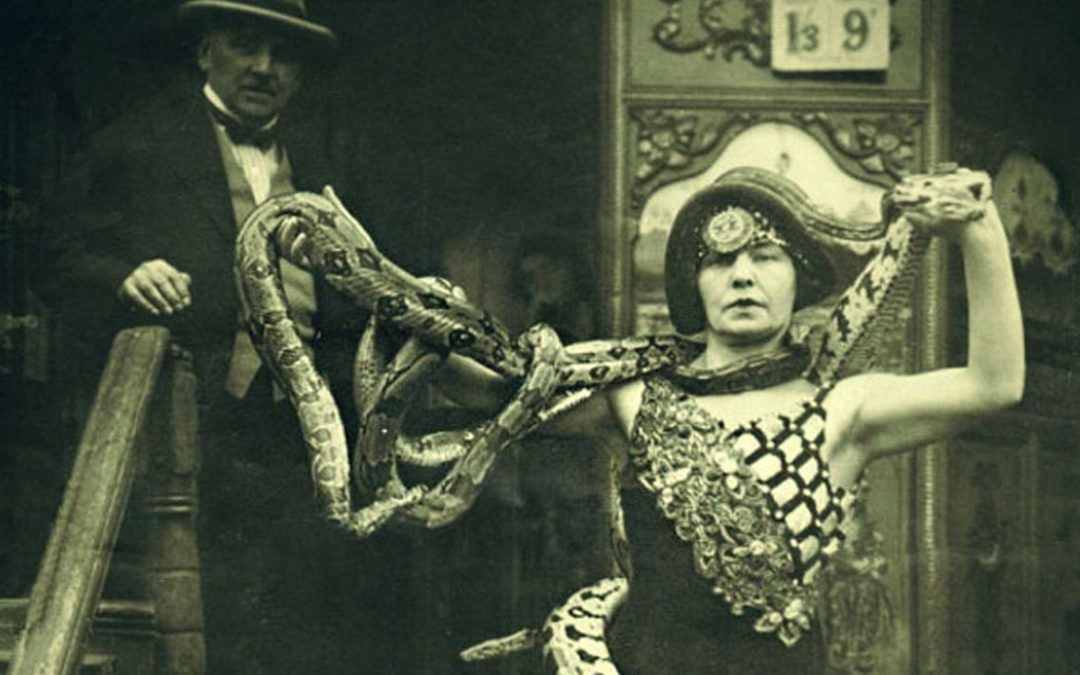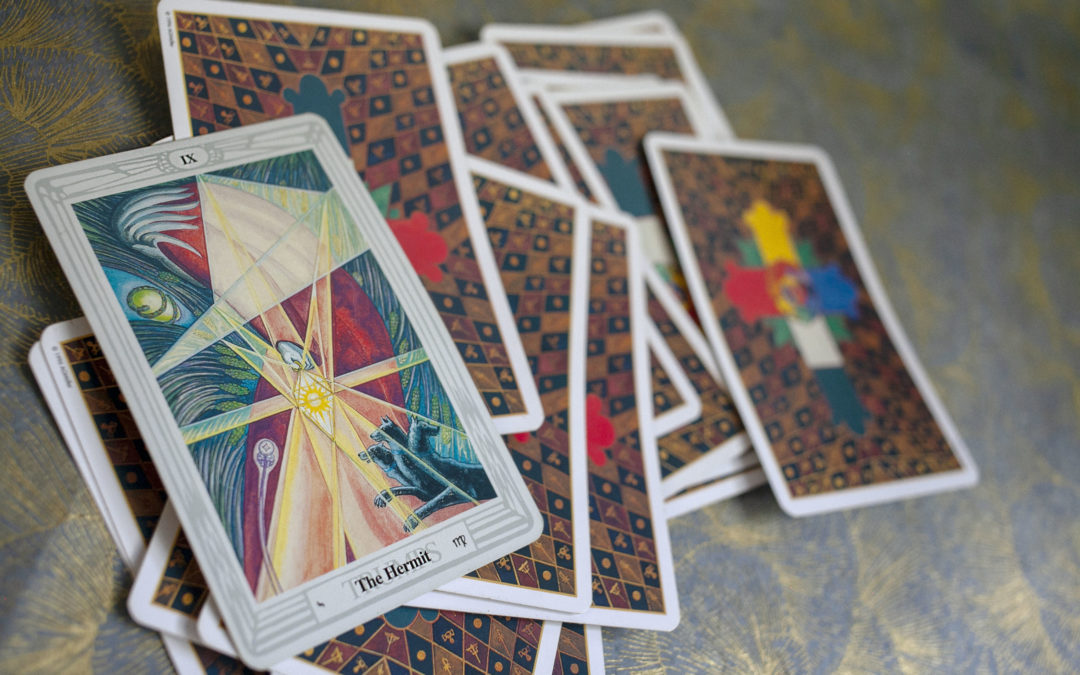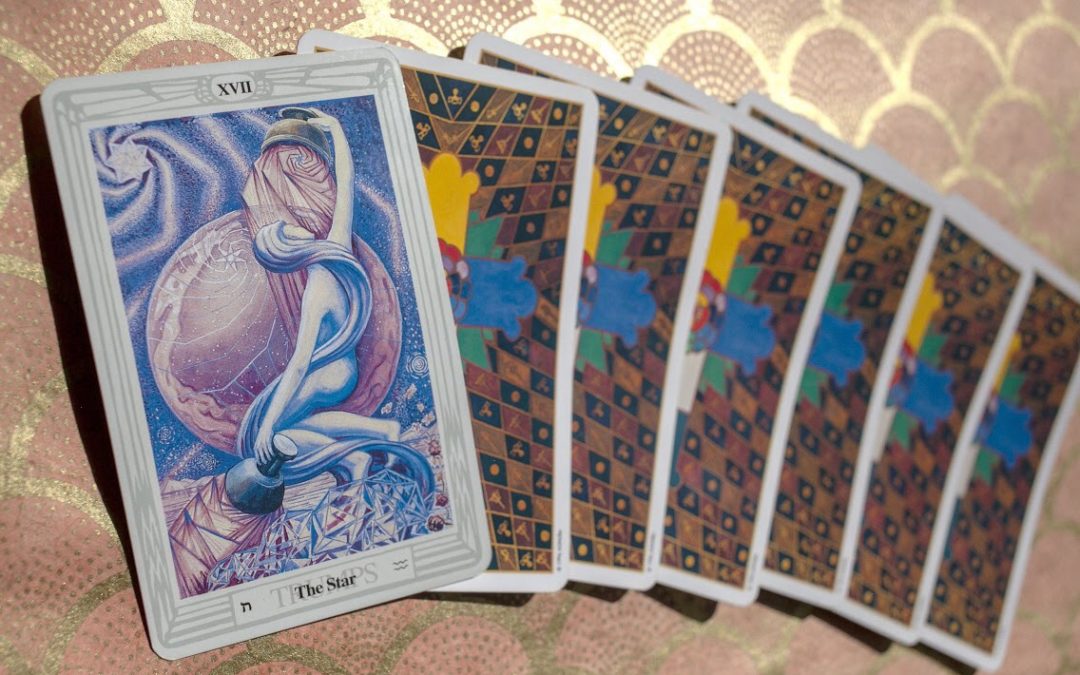
by Kosmic Tonic | Aug 8, 2019 | Tarot
Six months ago, close to the previous eclipses along the Cancer-Capricorn axis, Jasmine and I wedged our way through a shaft of the Great Pyramid at Giza. Tourists wilted on all sides from over-exertion or claustrophobia or heat stroke — it must have been a hundred degrees inside. Jasmine and I had experienced a few underworld journeys by this point in the trip, including a low-key syncopic seizure on my part that necessitated a trip to an airport hospital. By the time we squeezed our way back to the sunlight, salt crusting our foreheads from the sweat, hair dishevelled, eyes blinking out dust, we referred to the pyramid, wryly, as our birth canal.
The first card Jasmine and I drew, when we launched an earlier iteration of our website, was the Tower card. In some ways, it’s haunted us: that terrible tube-mouth, flashing out shards of fire, the tower itself cubist and fragmented, as if viewed from the reflection of a broken mirror. The eye of Horus, the anonymous angular shadows — inhuman in form, but like origami window jumpers. The entire card burning and bloodshot and red.
Whose heart doesn’t sink when they pull this card?
The astrological correspondence for this card is planetary Mars. Mars as fire, initiation, battlefield, destruction. In the sequence of the major arcana, the Tower follows the Devil, who is represented by the sign of Capricorn. Capricorn brings us stability, ninety degree angles (of walls and the roofs over our heads), systems, authority. The Tower card portrays the old system burning — Mars undiscriminating in its fire, with a drive only to level.
The author at Esoteric Meanings describes the Tower as the “glyph for the process of PURIFICATION THROUGH FIRE.” And that’s another way of understanding this Mars. The Hebrew letter assigned to this card is פ (pe), or mouth. But the mouth does not devour from hunger or avarice. Nor is the violence inspired from cruelty — no more than a natural forest fire or earthquake. A tide of destruction follows the tide of reaping as surely as winter follows harvest.
Sometimes, the structures we have leaned on need replacing, and the only way to do so is light a match. It’s uncomfortable. It might be wildly painful, at times. But it’s a re-birthing, too. This card turned out to be a fair representation of our journey so far, culminating (a year after we pulled it) with Jasmine’s study of the Qabalah, and her interpretation of this card as an internal alchemical process — indeed an alchemy of the soul. (For more on this, check out Jasmine’s recent talk at the Fresh Voices in Astrology Summit.)
Religions around the world include a form of ritual purification, whether to initiate the believer into the religion (such as a Christian baptism), or smudging to clear a space, or banishing, or carefully washing the body before prayer. We might think of Mars this way, as the knife that removes the tumour, or a flame that sterilizes the needle (or our etheric bodies / inner worlds.) In the Book of Thoth, Aleister Crowley compares this card to Shiva the Destroyer, who dances upon the bodies of his devotees. Crowley explains:
Briefly, the doctrine is that the ultimate reality (which is Perfection) is Nothingness. Hence all manifestations, however glorious, however delightful, are stains. To obtain perfection, all existing things must be annihilated.
Sounds extreme, but sometimes complete severance from the past (especially toxic habits, people, influences) is exactly what is required.
The next card in the sequence is the Star, which signals the return of hope, light, wonder and awe. Crowley concludes his chapter on the Star with words from Nuit, the goddess featured on the card, pouring water between two cups: I give unimaginable joys on earth: certainty, not faith, while in life, upon death; peace unutterable, rest, ecstasy; nor do I demand aught in sacrifice…Sing the rapturous love-song unto me! Burn to me perfumes! Wear to me jewels! Drink to me, for I love you! I love you! I am the blue-lidded daughter of Sunset; I am the naked brilliance of the voluptuous night-sky.
After all, a tide of sewing follows the tide of destruction once more.

by Kosmic Tonic | May 17, 2019 | Astrology
We’re so lucky to work with a community of talented and supportive women. Today we’re featuring writing from one of our good friends and collaborators, Colorado-based psychotherapist and all round magic lady: Kestrel Neathawk.
Where the light meets the water and everything begins to shimmer—it’s an ethereal and alchemical space, where Aphrodite, The Alchemical Goddess, wandering between my 12th and 1st whole sign houses, craves to be. If you stand just so, the Sun gently kisses your face with warmth. The leaves are backlit, in the caressing morning light—making it possible to see the network of veins coursing through translucent green. For a brief moment, in harmony with the elements that surround—water, earth, air, fire—Venus on the horizon embarks on a seemingly magical transformation from dark to light, visible then invisible. And before the Sun’s rays become too powerful, you might see her in a strand of a spider web—spanning between two trees or stalks of thistle—turning the delicate threads to silver and gold. It is in this moment that my very cellular make-up is also affected, my heart sings and the outward expression ignites a smile upon my face—a giggle if you listen closely. An inner glow transmuted outward. Peace washes over me. I feel at one with the Cosmos.
In Jean Shinoda Bolen’s book, Goddesses in Everywoman: A New Psychology of Women, she refers to Aphrodite as the Alchemical Goddess and what I am describing above is the golden light of Aphrodite Consciousness. Bolen states, “What is in the ‘limelight’ absorbs our attention. We are drawn effortlessly toward what we see, and we are relaxed in our concentration…It is in her style to be genuinely and momentarily involved in whatever interests her.” Bolen goes on to say, that Aphrodite Consciousness is neither “focused consciousness” nor “diffuse awareness,” that the Virgin Goddesses (Artemis, Athena and Hestia) and Vulnerable Goddesses (Hera, Demeter and Persephone) possess. Aphrodite Consciousness is “a third mode of operation” and naturally brings-to-mind my work as a psychotherapist and budding astrologer. Psychotherapy is a complex art of listening deeply (beholding). It requires the beholder to make associations/connections while also keeping in mind the complex cosmology of the client—incorporating/balancing/weighing their past, present, personal narratives, cultural backgrounds, internal archetypes coupled with the psychotherapist or astrologer’s own emotional response to the information being conveyed. It has been my experience, that when a client comes to me, there is a desire to be seen and ultimately change. Something isn’t working anymore or must be integrated and understood differently in order to proceed forward on whatever the individual evolution is calling for. While doing work with clients, it helps me to picture an infinite, divine and unique Universe inside of each individual (the natal chart) while simultaneously reminding myself that I’m only getting a small snapshot of the larger picture, yet I am also involved in a reciprocal process of interchange that requires the combination/mixing of two souls. Honest and vulnerable, I am also being touched in equal parts by my client. The transformational process is a balancing act, as it requires both healthy boundaries to minimize transference/countertransference, but enough receptivity to invite attunement, compassion and resonance, in order for the client to feel safe enough to invite openness in the process. Jung noted that the therapeutic (or analysis) deeply affected both the client and therapist: “For two personalities to meet is like mixing two different chemical substances. If there is a combination at all, both are transformed.”
“Whenever Aphrodite consciousness is present, energy is generated: lovers glow with well-being and heightened energy; conversation sparkles, stimulating thoughts and feelings. When two people truly meet each other, both receive energy from the encounter and feel more vitality than before, regardless of the content—which, in therapy (or the astrological consult), can be very painful material. Work becomes invigorating rather than draining. Absorbed by whom we are with, or by what we are doing, we lose track of time—a characteristic that Aphrodite shares with Hestia.” ~Bolen

by Kosmic Tonic | May 9, 2019 | Astrology
When did we learn to fear snakes?
The Hebrew name for Eve, Hawwah (or Havvah or Chavah) has been translated to “mother of all living,” or simply “life” or “breath.” But scholars have also traced the etymology to words for serpent, possibly from the Phoenician snake goddess Havat, or the term for beast of the field, chevya.
As Mary Condren writes in The Serpent and the Goddess, snakes mediate the relationship between the divine feminine and human culture. I think of the Minoan snake-goddess figurines found at archaeological sites in Crete or the Egyptian Wadjet, a serpent-moon Goddess, or Lilith, the scapegoat for all feminine wickedness (/ bad-assery.) Some histories credit snakes with helping the Sun rise. A winged serpent was carved onto the tomb of Rameses VI with the words: “She who causes to rise before Re. It is She who leads the Great God in the gate of the Eastern horizon.”
Snakes are inherently regenerative, and for this reason, they represent cycles of death and rebirth. Regrowth. Serpents slough their old skin as women shed their uterine lining once a month. Perhaps for this reason too, snakes represent a particular, inner wisdom—what Jung called gnosis: a “thinking from the intestines… a knowledge that comes from the blood.”
Maybe because her head is inseparable from her heart or her tail, the Serpent bridges paradox. The biblical snake leads us from innocence to experience; the Serpent in the Egyptian Book of the Dead wavers between “loving and hating the gods.” This wavering is internalized in the Hebrew letter connected to Serpent: Teth (ט). One Hebrew learning site describes Teth as a paradoxical letter, for its inverted form “reveals both good and evil.” Interestingly, this letter has been assigned to one of the Tarot’s more feminine major arcana: Strength (Lust in the Thoth deck), which invariably features a woman taming or riding a lion. This is the card that represents the zodiacal sign of Leo, whose sigil resembles a serpent too: ♌︎.
After Eve eats from the Tree of Knowledge, God curses the snake: “You will crawl on your belly and you will eat dust all the days of your life.” Nor does He stop here. Like a jealous boyfriend, God announces he will make Snake and Woman hate each other: “her offspring and yours will always be enemies. Her offspring will crush your head, and you will bite her offspring’s heel.”
To Woman, he says: “I will increase your trouble in pregnancy and your pain in giving birth. In spite of this, you will still have desire for your husband, yet you will be subject to him.”
And to Man: “You listened to your wife and ate the fruit which I told you not to eat. Because of what you have done, the ground will be under a curse. You will have to work hard all your life to make it produce enough food for you.”
Is it just me, or is the condemnation of the snake yoked to the roots of modern patriarchy?
And yet, we inscribe her form onto our ambulances by way of Asclepius’ healing rod or Hermes’ caduceus. Snakes were considered sacred in Ancient Greece. Their tendency to regenerate offered hope for those seeking a cure, and on a practical level, their venom had healing properties.
Last year, a bull snake visited Jasmine and me in Colorado. We shrieked and laughed. I climbed onto my chair. Yet even as I captured a ridiculous video for Instagram, the snake’s presence felt like a message, or messenger. We were working with Lilith at that time, a Goddess (quite literally) demonized for her subverting her slice of the patriarchy.
In this thorough post about Lilith, one commenter encapsulates her (and Snake more generally) with a lyric by Norwegian black metal band Satyricon. It feels fitting to conclude here, in the imagined words of Lilith: Damn you all for being so small.
References
The Archetypal Symbolism of Animals by Hannah Barbara
Goddess and the Serpent by Mary Condren
“Hebrew Word Study” by Skip Moen
Hebrew for Christians

by Kosmic Tonic | Apr 29, 2019 | Tarot
No matter what deck you use, the Hermit never seems to look at you head-on. In this version, he buckles into the wheat, face barely even in profile. His hand forms the centre of the card, which is appropriate, given the Hebrew letter associated with the Hermit is Yod (י), which translates to “hand.” This letter has been said to represent the “divine spark”: “the first dot with which the scribes first start writing a letter, or the last dot that gives a letter its final form,” according to the Likutei Maharan.
The grapheme of the Yod, that diminutive tick, forms the foundation of all Hebrew letters—as all written words begin with a hand.
I’ve always associated the sign Virgo with the hand: the hand writing or weaving, the precision and sensitivity of our fingers, which no machine can quite replace or replicate. Our hands opened in offering or clasped in prayer or simply feeling forward. The astrological correspondence of this card is, indeed, Virgo. When that thought truly landed for me, it changed how I conceived the word virgin.
It has been said that the pre-patriarchal definition of “virgin” described someone who was independent and self-sovereign. This theory resonates, though I can’t find a historical or etymological backing for it. In all likelihood “virgin” from “virgo” described simply a girl.
Today, the words Hermit and Virgin both suggest someone un-coupled, in a state of seclusion or retreat. The only difference is we conceive the virgin as somehow in-waiting, “eligible.” If we divorce, for the moment, chastity from the idea of goodness (and from the quasi-imperial fetishization of conquering “unspoilt” or “unclaimed” bodies), Virgin and Hermit are the same. Both turned from the world, maybe inward or upward, or backward or forward, like the 3-headed Cerberus on this card. But importantly: not at you.
Demetra George has written of Vesta as complete-in-herself, her libido flowing divinely upward rather than to another person. And here enters an alternative understanding of the Hermit: as priestess or seeker. The Fool on her journey toward knowing. In the language of witchcraft, new students are described, simply, as seekers.
Though I understand the hesitation to conflate signs with houses—and assume co-equivalence between Virgo and the 6th house—there is a meaningful echo here. I connect the 6th house to ritual: the humility of sweeping a practice space, cleaning the altar, polishing the chalice. Opposite the 6th is the 12th house: that space of seclusion and study, shadow work, occasional dark nights.
Aleister Crowley connects this card to the Persephone story. He evokes Mercury (ruler of Virgo) as Psychopomp, our guide into Other or Underworlds. This is a common theme: the virgin (or seeker or hermit) entering the shadow realm, the nether regions of their mind or spiritual quest. In the story, Ceres / Demeter destroys our crops in her rage and grief and desperation to return her daughter from Hades. She’s successful, in part. But Persephone, as we knew her, has changed. She’ll return to the underworld again next winter, and with her, the crops will freeze. Interesting, the background of wheat in this card, especially when you note that the brightest star in the constellation of Virgo is Spica, which is Latin for “ear of grain.”
According to Crowley, this card represents fertility in its most exalted sense, not to be mistaken with the narrow, procreative definition of the word. Rather, he means fertility as potential, more perfect because it is unformed. Fertility as yod or hand or divine spark. And so, I can’t see the Virgin as a maiden-in-waiting or a glorified Bachelorette. She’s the Hermit, the Nun, the Priest, the Thinker, the Creatrix, hands busied in weaving, writing, offering and prayer.

by Kosmic Tonic | Mar 23, 2019 | Tarot
Here we find Nuit / Nuith / Nut, the Goddess of Night in her manifest (that is, physical) form. We studied this figure in our exploration of the Aeon card, which featured Nuit in her “formless form,” back-bending in infinite space over Horus. That tension between form and formlessness feels appropriate for the major arcana card that corresponds to Aquarius: a sign of the least embodied element (air), ruled by Saturn, who deals in structure.
As in the Rider-Waite-Smith rendition of the card, the sign Aquarius arrives in the shape of the water bearer: the figures in both decks occupied in the labour of pouring. In the R.W.S. version, the woman kneels with one foot on the earth, the other under-water, implying a bridge between form and formlessness, or boundaries and boundaryless-ness. I’ll come back to this bridge, for it captures something of the essence of Aquarius.
Crowley linked this card to the Hebrew letter heh, which means window. As the author at Esoteric Meanings points out, a window’s main function is to transfer light: like the stars (or our stars, the sun.) When considering the sign of Aquarius, I am taken with how light might also represent knowledge or “enlightenment.”
The R.W.S. version of this card features an eight pointed star, which is mythologically associated with the Star of Ishtar or Inanna (and thereby Venus.) This makes sense for an astrologer, because we know planetary Venus draws her own star around the ecliptic in eight year cycles. Crowley’s star has seven points, which is known as the Elven or Fairy star (and used as a symbol of the A.A, the inner order of the O.T.O., of which Crowley was one of the most famous members.) Again, as an astrologer, I associate seven with the planet Saturn, the 7th “wandering star” counted in traditional astrology. Of course, we also count his cycle in seven year increments, or Saturn squares. Interestingly, Crowley links the seven-pointed star to Venus as well, as Venus rules the 7th sphere on the Tree of Life: Netzach.
This blurring between Venus and Saturn feels significant, as it catches on the inherent tension of this card, one of the most aesthetically “feminine” and nocturnal in the deck, though it correlates to a traditionally “masculine” and diurnal sign. In his Book of Thoth, Crowley describes the water in the background of this card as the “great sea of Binah,” the 3rd sphere on the Tree of Life, which relates to intuitive understanding, contemplation, and the womb that gives shape to the spirit of God. What is the planet we associate with this sphere? None other than Saturn.
That Saturn might be considered a feminine planet is not a new concept in astrology. In the Hellenistic text, Carmen Astrologicum, Dorotheus says: “…the feminine planets are Saturn, Venus and the Moon, the masculine ones are the Sun, Jupiter, and Mars.” Though Dorotheus is the only astrologer who asserts the femininity of Saturn (to my knowledge), the notion does offer a pleasing symmetry between the nocturnal / diurnal and masculine / feminine planets. For more information on the theory of Saturn as a feminine planet, and particularly Saturn as Crone, check out Charles Obert’s excellent discussion on the subject at Student of Astrology.
This polarity between diurnal and nocturnal is further represented on the card between the gold and silver chalices: the former, solar, the latter lunar, or even Saturnian. Indeed, this imagery calls to mind the axis between sun-ruled Leo and his opposite: wintry, Saturn-ruled Aquarius. As suggested earlier, there is an inherently bridging quality in the archetype of Aquarius. Many Aquarians I know take for granted the assumption (radical for some) that we should share, cooperate, freely exchange our efforts and our ideas. On the one hand, Aquarius is independent, free-spirited, intellectually expansive, as represented by the Air element. On the other hand, Aquarius is fixed in belief, tethered to logic, if their own, ingeniously innovated. This sign is the water-bearer, but not water. Aquarius conveys the water of knowledge in the Saturn structure of two vessels or cups.
In his Book of Thoth, Crowley suggests that to understand this card, one must understand the first chapter of the Book of the Law, which chronicles the manifesting of Nuit and her masculine counterpart, Hadit. Several lines from this text underline the divinity and uniqueness in all of us, another egalitarian (and Aquarian) concept. Crowley writes: “every man and every woman is a star,” and later: “For he is ever a sun, and she a moon. But to him is the winged secret flame, and to her the stooping starlight.” In the mouth of Nuit, Crowley continues: “I am the blue-lidded daughter of Sunset; I am the naked brilliance of the voluptuous night-sky.”
In addition to heh, The Star has been linked to the Hebrew letter tzaddi, which means fish hook. Traditionally, tzaddi has also been assigned to the Emperor, and the two cards appear interchangeable in the Golden Dawn list of correspondences. In The Law is For All, Crowley writes: I see no harm in revealing the mystery of Tzaddi to ‘the wise’; others will hardly understand my explanations. Tzaddi is the letter of The Emperor, the Trump IV, and He is the Star, the Trump XVII. Aquarius and Aries are therefore counterchanged, revolving on the pivot of Pisces, just as, in the Trumps VIII and XI, Leo and Libra do about Virgo. This last revelation makes our Tarot attributions sublimely, perfectly, flawlessly symmetrical.
I won’t spend more on the Golden Dawn correspondences between the Hebrew letters and the tarot keys, but again I find it worth pausing on, this symmetry and swapping between genders: The Star for the Emperor; the Goddess of Night as Aquarius; the womb, Binah, as Saturn. It does feel appropriately Aquarian, this defying of convention, at once rigid in its logic and contra-normative.
Angeles Arrien’s description for The Star quotes Heidegger, who says: “a person is not a thing or a process, but an opening through which the Absolute can manifest.” Arrien elaborates on this sentiment: “the Star card reminds us that each of us is an opening for light, or a gateway through which the Absolute can manifest.” That is God, or divinity, or Spirit.
If any sign recognizes the divinity in all of us, and the collective light that pools when we work together, it is Aquarius. And maybe that contributes to the feminine thread of Saturn: the wise woman goddess who sees herself reflected in you, the womb as a pliant container for life, but ultimately, still a structure.
References:
Liber AL vel Legis by Aleister Crowley
The Book of Thoth by Aleister Crowley
The Law is For All by Aleister Crowley
Student of Astrology by Charles Obert
Esoteric Meanings





